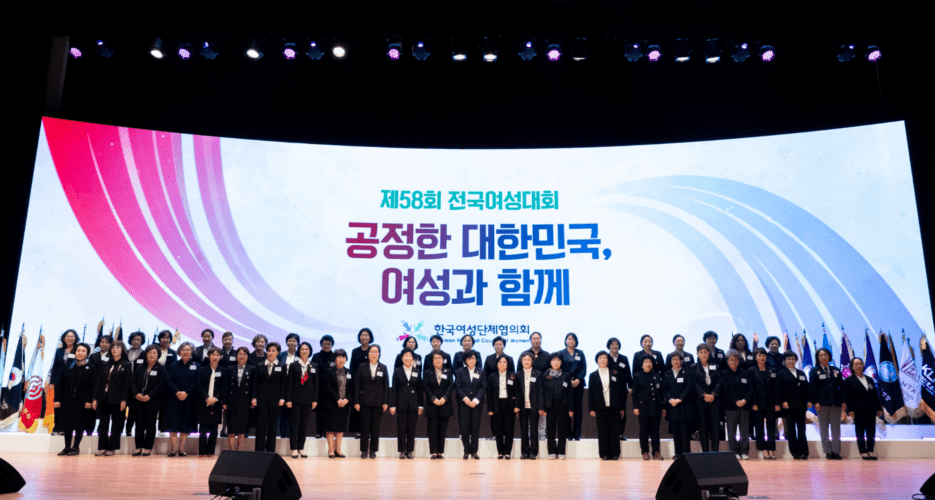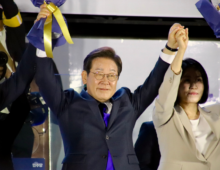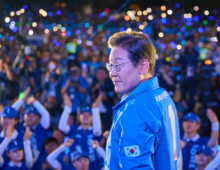|
Analysis Election Watch: South Korean parliament’s female representation likely to erodeExperts tell Korea Pro that despite promises from major parties, female political representation will remain low Jeongmin KimMarch 8, 2024  Korean National Council of Women hosted the 58th National Women’s Conference under the theme ‘A Fair Republic of Korea, Together with Women,’ Nov. 1, 2023 | Image: Korean National Council of Women Editor’s note: Korea Pro’s regular ‘Election Watch’ series covers key political developments in South Korea leading to the April 10 General Elections. South Korea faces significant risks due to the persistent underrepresentation of women in its National Assembly, including legislative gender inequality, unfulfilled commitments by political parties and the limited influence of elected female lawmakers. Despite promises from the country’s two major parties to nominate women for 30% of their district vote positions, neither has upheld this commitment as of Friday, suggesting the 22nd National Assembly may once again have one of the lowest female representation rates among Organization for Economic Co-operation and Development (OECD) countries. Over the past decade, the 20th and 21st assemblies have seen slight improvements, with 51 and 57 women elected, respectively. However, with only 57 seats out of the National Assembly’s 300, South Korea barely surpasses North Korea and remains lower than China in terms of female representation. Experts told Korea Pro that for South Korea to be recognized as a global pivotal state, it must enhance legislative gender equality. However, as major and smaller parties finalize their nominations by mid-March, trends indicate a low number of female candidates. ONE OF THE WORST IN THE WORLD South Korea’s journey toward gender balance in politics has seen modest progress, with the number of female lawmakers increasing from just two out of 300 in the 2nd National Assembly to 57 (19% of lawmakers) in the 21st National Assembly in 2020. This improvement, particularly in proportional representation, resulted from election law amendments requiring parties to nominate women for at least half their proportional slots and place them in odd-numbered positions on ballots. However, despite these gains, South Korea’s female representation in the National Assembly remains among the lowest in the world, lagging behind the OECD average of 33.8%, the global average of 25.6%, and the Asian average of 20.8%. Minjeoung Kim, a professor of International Relations at the University of Seoul, told Korea Pro that countries like France, Spain and Belgium are moving from limited gender quotas toward stricter 50:50 rules. In Latin America, Mexico and Ecuador are among eight countries that have adopted equal quota systems. Jong-Hee Lee at the National Election Commission of the Korean Civic Education Institute for Democracy told Korea Pro that Mexico’s successful electoral reform resulted in women comprising 51% of the Senate and 48.2% of the House of Representatives following the 2018 election after decades of experiencing a political culture similar to South Korea’s. Lee attributed this achievement to a gender quota system that required women to account for 30% of nominations, which was later increased to 50% in 2015. He suggested that South Korea could adopt Mexico’s strategy to curb the practice of nominating male candidates in easy-win areas. 2024 FORECAST Experts predict that the number of female lawmakers in the upcoming April elections is unlikely to surpass previous figures, despite the 50% women’s proportional representation quota. Minjeoung Kim from the University of Seoul noted that district nominations are likely to fall short of gender balance commitments, continuing the trend from the 2020 election, where major parties failed to fulfill their 30% promise. The situation is further complicated by major parties siphoning lawmakers into their satellite parties, making the 50% women’s nomination rule somewhat ambiguous. Additionally, the youth nomination rate is low, with few young candidates positioned in winnable districts. South Korea’s election law and party charters for the People Power Party (PPP) and the Democratic Party (DP) state that parties should “strive” to recommend women for over 30% of their district candidates, but these rules have never been fully complied with. The DP also has a mandatory regulation to recommend young candidates for more than 10% of seats, but it has not significantly impacted primary outcomes. Consequently, the 22nd National Assembly is poised to be predominantly male, in their 50s and 60s, despite incentives for young and female candidacies by the two major parties.  The Korean National Council of Women holds a press conference calling for 50% female candidate nominations in the 21st General Election, Feb. 20, 2020 | Image: Korean National Council of Women CAUSES OF INEQUALITY Experts highlighted a persistent male dominance in political party recruitment this year, more pronounced than in the previous election, partly due to how the election is shaping up to be a neck-and-neck competition for the two major parties. The PPP’s female district nominations stand at 12%, while the DP’s are at 15%, with new female recruits representing less than 30% in both parties, mainly from legal and science backgrounds. Experts point to a “misguided belief” implicitly held at the National Assembly that increasing female political representation could alienate male voters, hindering progress toward gender parity. Despite calls for higher women’s nomination quotas, tangible actions remain scarce. The New Futures Party, led by DP defector Lee Nak-yon, is the only notable exception, pledging a 30% women’s nomination quota, though its applicability to this year’s election remains uncertain. Incentives for party leaders to nominate more women have been introduced, with the PPP and DP offering bonus points based on age and gender. However, a regression in the Political Funds Act now allows parties to receive subsidies for nominating women for just over 10% of district seats, down from the previous 30% threshold. Kim Eun-joo, co-founder of the Women’s Party and director of the Center for Korean Women & Politics, told Korea Pro that while female representation in proportional representation is institutionally resolved, the next step is to improve the district voting system. “Making the 30% district quota mandatory and introducing enforcement measures for noncompliance is crucial for the future,” she said.  Liberty Party Korea lawmakers, including Kim Soon-rye (center), hold a press conference at the National Assembly, Sept. 4, 2017 | Image: Kim Soon-rye via Naver blog DIFFICULTIES WHEN TAPPED — OR ELECTED Under South Korea’s two-party system, a significant barrier to equal representation in parliament arises when female candidates from opposing parties contest the same district, leading to the elimination of one and halving their collective presence. In the 21st general election, this scenario played out in seven districts, reducing 14 female candidates to seven. Typically, about half of the female candidates are incumbents, while the rest are political novices or contesting in non-traditional areas. Their success rates against seasoned male incumbents from the opposing party are notably low, with few exceptions in the previous election. Moreover, women who receive nominations often hail from elite circles, such as the Blue House, or the legal profession — sectors in South Korea known for their significant barriers to female advancement.  Democratic Party lawmaker Kim Sang-hee becomes the South Korean National Assembly’s first female vice speaker since 1948, May 15, 2020 | Image: Kim Sang-hee via Facebook TRAPPED IN A MAN’S WORLD Many elected female politicians have often aligned with factional or partisan interests for their own political survival rather than challenging prevailing norms, experts told Korea Pro. Kim from the University of Seoul observed that current female National Assembly members seldom prioritize women’s issues, typically following party leadership’s directives to secure future nominations. “Without parliamentary effort, advancing gender-related laws is difficult, relying on civil groups or external pressures. Female politicians, a minority, remain marginalized and lack solidarity,” Kim said. An expert advising the National Assembly on the electoral system cited the existence of “no-women zones” in certain committees as a reason for female lawmakers’ struggle to overcome party inertia on gender issues, requesting anonymity due to their current role. “There’s a bias where men are preferred as chairpersons, especially in committees like national defense. Older men often band together and agree on decisions behind closed doors, and this culture of pre-arranged chairmanship continues. The low number of female lawmakers becomes a cyclical problem affecting future elections,” they explained. Kim Eun-joo, director of the Center for Korean Women & Politics, noted a generational divide, with young men viewing the female quota as “special treatment,” influencing party attitudes toward female nominations and policies that appear to benefit women. “If we look at the voter breakdown in the 2022 local elections and the presidential election results, there is a noticeable difference in voting tendencies based on age and gender. Women in their 20s and early 30s tend to support progressive parties, while men of the same age group tend to support conservative parties.” The voting gap between genders, larger than in the past, indicates that parties view gender conflict as an electoral strategy rather than an issue needing parliamentary resolution, she stated.  Korean National Council of Women hold a policy seminar discussing expanding women’s political participation at the National Assembly, Nov. 20, 2023 | Image: Korean National Council of Women POLICY IMPLICATIONS Achieving near gender parity in parliament could address key societal issues, such as the low birth rate and elderly care, predominantly managed by women in Korean society, Minjeoung Kim from the University of Seoul told Korea Pro. “For the National Assembly to truly transform, reaching beyond policy outcomes to the essence of the policy-making process and discourse, female representation needs to surpass 30% — the threshold of critical mass,” she emphasized. Kim Eun-joo, director of the Center for Korean Women & Politics, acknowledged the progress over the last thirty years, noting an increase in gender and family-related legislation with more women in parliament. “This shift occurs as women parliamentarians often highlight issues affecting women and other vulnerable groups,” she stated. “But the notion that women-centric legislation only serves one gender’s interests is misconceived. Women constitute half the society; advancing their rights benefits everyone, enhancing the well-being of their families and broader social networks.” Lina Park contributed reporting to this article. Edited by John Lee Editor’s note: Korea Pro’s regular ‘Election Watch’ series covers key political developments in South Korea leading to the April 10 General Elections. South Korea faces significant risks due to the persistent underrepresentation of women in its National Assembly, including legislative gender inequality, unfulfilled commitments by political parties and the limited influence of elected female lawmakers. Get your
|
|
Analysis Election Watch: South Korean parliament’s female representation likely to erodeExperts tell Korea Pro that despite promises from major parties, female political representation will remain low  Editor’s note: Korea Pro’s regular ‘Election Watch’ series covers key political developments in South Korea leading to the April 10 General Elections. South Korea faces significant risks due to the persistent underrepresentation of women in its National Assembly, including legislative gender inequality, unfulfilled commitments by political parties and the limited influence of elected female lawmakers. © Korea Risk Group. All rights reserved. |











